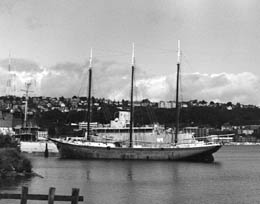Between 1891 and 1950, sailing schooners based in Seattle, Poulsbo, and Anacortes fished cod in the Bering Sea and Alaskan waters. Famous vessels included the Lizzie Colby, Joseph Russ, C S Holmes, Charles R Wilson, John A, William Nottingham, Sophie Christenson, Wawona, and C A Thayer, of which only the last survives.
An Accidental Fishery
In 1857, the San Francisco brig Timandra became ice-locked at the mouth of the Amur River in Siberia and inadvertently discovered the ease of fishing for cod in the frigid North Pacific. The vessel returned in 1863 with 25 tons of salt to preserve a substantial catch (refrigeration came along in the 1900s). Although the large fish, which school in coastal waters or above shallow oceanic banks, proved elusive on this particular trip, America's North Pacific cod fishery was established.
San Francisco's cod fleet had grown to five vessels by 1891, when Captain J. A. Matheson began operating the Lizzie Colby from Seattle. Poulsbo and Anacortes also became home ports for cod schooners, and by 1906, Puget Sound vessels surpassed California's fleet by taking more than a million tons of fish in a single season. With the introduction of refrigeration, the Port of Seattle's Bell Street Pier became a major center for the cod fishery.
Most of the fishery's larger schooners were converted from hauling lumber, including the California-built Wawona -- the fleet's heavyweight champion at 413 tons -- and the four-masted Sophie Christenson, launched from Port Blakely. Cod salting and packing plants were built in Alaska and on Puget Sound to process the catch.
Hard, Dangerous Work
Cod fishing was arduous and risky work in the rough North Pacific seas. Cod, weighing up to 10 pounds, were caught on baited lines and hauled by hand aboard small dories, which operated from schooners anchored along the coast or above relatively shallow banks amid deeper seas. Dory fishermen, many of them veterans of the Grand Banks of the North Atlantic, typically launched their boats at 4:30 a.m. and completed two shifts of fishing by 6:30 p.m., when they returned to the schooner for the night.
Storms were common and especially dangerous in the shallow waters where cod congregated. The Seattle-owned schooner Nellie Colman was lost with all 29 aboard in a mid-November 1910 storm off the Alaskan coast.
Fish Wars
Despite these perils, the Puget Sound fleet grew to eight vessels by 1915. America's entry into World War I created a new market for preserved cod. Completion of Ballard's Government Locks (now named for Hiram R. Chittenden) in 1917 provided the schooners access to winter anchorage in Lake Union's fresh water, which killed the boring parasites that plagued their wooden hulls.
During the 1930s, Japanese fishermen, operating from steam- or diesel-powered factory ships, began to work the Bering Sea and Alaskan coast in growing numbers. On May 24, 1938, an infuriated Captain J. E. Shields, sent a telegram over an open radio frequency from the Sophie to Bristol Bay asking for a "dozen high powered rifles and plenty of ammunition" with the stated aim of ejecting his Japanese competitors. The federal government scrambled to prevent a shooting war, and the Japanese fishing fleet retreated.
End of the Season
After a different Japanese fleet attacked Pearl Harbor in 1941, all but one of the Seattle cod schooners were commandeered by the U.S. government for barge and transport duty in the North Pacific. The sailing fishery never recovered, and in 1950, the C A Thayer, was the last of her kind to fish the Bering Sea. She now operates as a school ship from San Francisco's Fisherman's Wharf.
The rest of this noble family of ships met sad ends as scrap or dismasted barges. The Wawona, was maintained at Lake Union's Northwest Seaport and spent nearly three decades educating visitors and serving as a very visual example of the region's maritime history.
In 2005, the effects of water intrusion and a beetle infestation made it clear that the Wawona's future was dire unless she could be completely restored. Faced with an estimated $15 million bill to repair her severe decay, Northwest Seaport made the difficult decision to demolish the Wawona. Portions of the ship, including the captain's cabin, were salvaged for planned display at the Museum of History and Industry when that organization relocates to the Naval Reserve Building (Armory).

